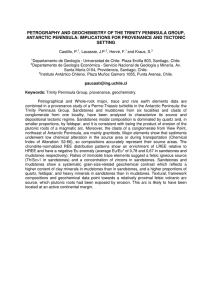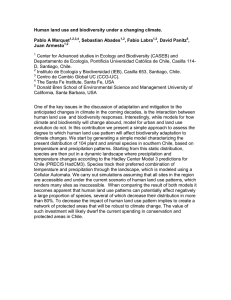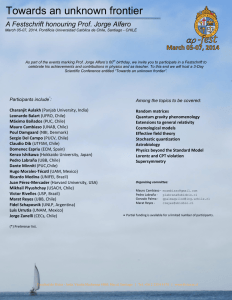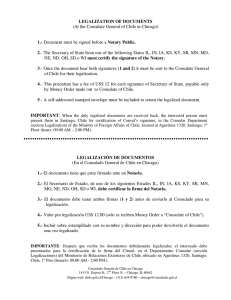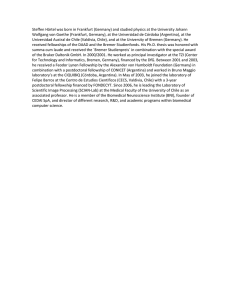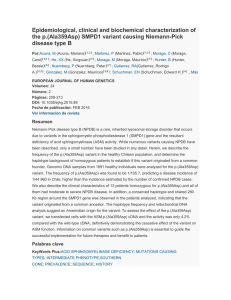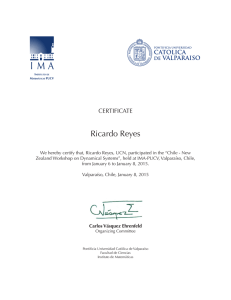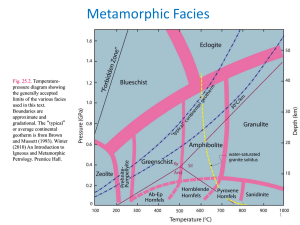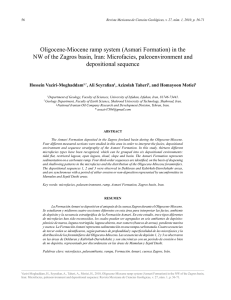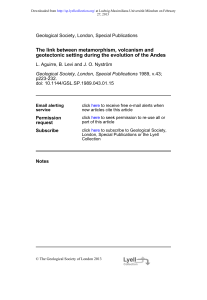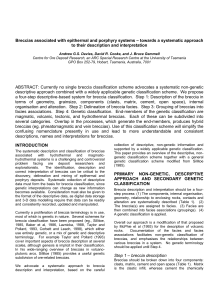Shoreface and estuarine deposits in the Oligocene Gaudal
Anuncio
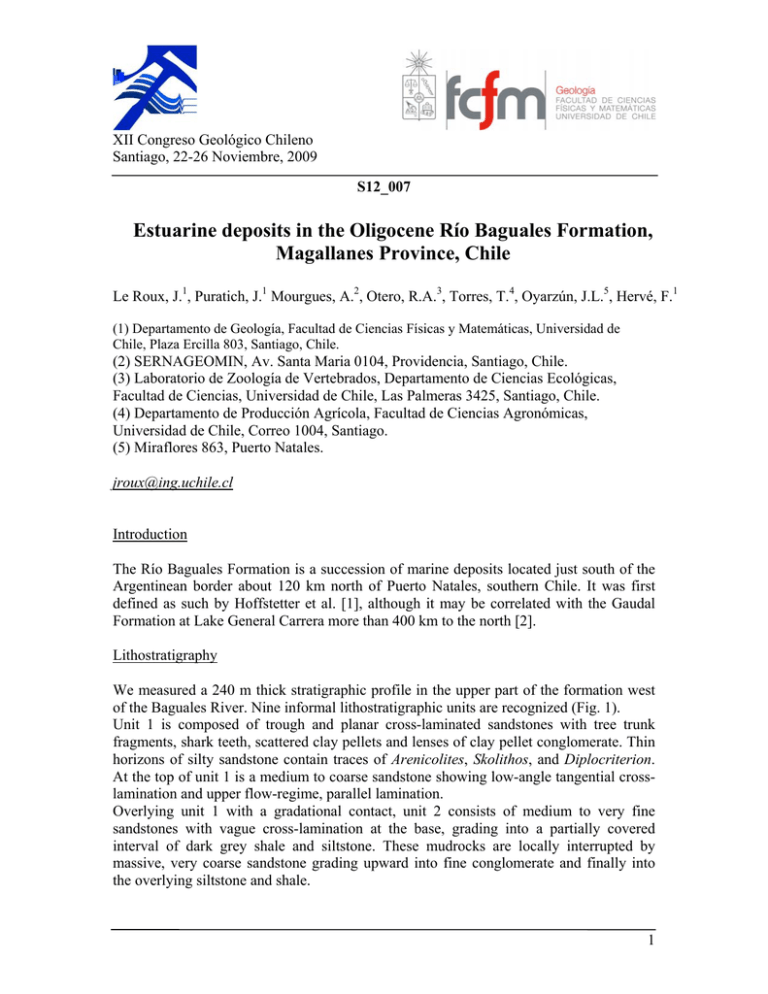
XII Congreso Geológico Chileno Santiago, 22-26 Noviembre, 2009 S12_007 Estuarine deposits in the Oligocene Río Baguales Formation, Magallanes Province, Chile Le Roux, J.1, Puratich, J.1 Mourgues, A.2, Otero, R.A.3, Torres, T.4, Oyarzún, J.L.5, Hervé, F.1 (1) Departamento de Geología, Facultad de Ciencias Físicas y Matemáticas, Universidad de Chile, Plaza Ercilla 803, Santiago, Chile. (2) SERNAGEOMIN, Av. Santa Maria 0104, Providencia, Santiago, Chile. (3) Laboratorio de Zoología de Vertebrados, Departamento de Ciencias Ecológicas, Facultad de Ciencias, Universidad de Chile, Las Palmeras 3425, Santiago, Chile. (4) Departamento de Producción Agrícola, Facultad de Ciencias Agronómicas, Universidad de Chile, Correo 1004, Santiago. (5) Miraflores 863, Puerto Natales. jroux@ing.uchile.cl Introduction The Río Baguales Formation is a succession of marine deposits located just south of the Argentinean border about 120 km north of Puerto Natales, southern Chile. It was first defined as such by Hoffstetter et al. [1], although it may be correlated with the Gaudal Formation at Lake General Carrera more than 400 km to the north [2]. Lithostratigraphy We measured a 240 m thick stratigraphic profile in the upper part of the formation west of the Baguales River. Nine informal lithostratigraphic units are recognized (Fig. 1). Unit 1 is composed of trough and planar cross-laminated sandstones with tree trunk fragments, shark teeth, scattered clay pellets and lenses of clay pellet conglomerate. Thin horizons of silty sandstone contain traces of Arenicolites, Skolithos, and Diplocriterion. At the top of unit 1 is a medium to coarse sandstone showing low-angle tangential crosslamination and upper flow-regime, parallel lamination. Overlying unit 1 with a gradational contact, unit 2 consists of medium to very fine sandstones with vague cross-lamination at the base, grading into a partially covered interval of dark grey shale and siltstone. These mudrocks are locally interrupted by massive, very coarse sandstone grading upward into fine conglomerate and finally into the overlying siltstone and shale. 1 XII Congreso Geológico Chileno Santiago, 22-26 Noviembre, 2009 Unit 3 is represented by large-scale, high angle planar cross-bedded sandstones and conglomerates. Each cross-bed is composed of 5–10 cm of conglomerate grading into 10–20 cm of coarse sandstone, with recorded dips of 20 - 27º towards the N and NW. Conglomerates containing oysters, bivalves and gastropod fragments grading into sandstones with clay and conglomerate lenses constitute unit 4, whereas unit 5 is similar to unit 2. Unit 6 is formed by horizontally laminated, medium-grained sandstone with conglomerate lenses overlain by fine to medium, trough and planar cross-laminated sandstone with clay and shale lenses. The latter are oxidized and partially bioturbated. Units 7 and 8 are similar to units 4 and 6, respectively. The latter also contains fine sandstone lenses with Polykladichnus traces and plant fragments. Unit 9 resembles unit 2, but is interrupted by trough cross-laminated sandstone coarsening upward into conglomerate, which in turn grades through very fine sandstone into siltstone and shale. Facies description and paleoenvironmental interpretation Facies 1 consists of fine to coarse, trough and planar cross-laminated sandstone with traces belonging to the Skolithos ichnofacies. The latter indicates the presence of suspension-feeding organisms filtering organic material kept in suspension by wave or current action or deposited during slack periods [3]. The presence of tree trunks and leave fragments suggest a somewhat sheltered environment interpreted as a flood tidal delta. A tooth crown of Odontaspididae cf. Carcharias (sand tiger shark) supports a shallow water environment. This genus is an extant littoral shark inhabiting banks, reefs and troughs in sandy areas, from the intertidal zone to about 200 m, with most found at depths of 15 – 25 m [4]. The uppermost part of unit 1 is formed by sandstone with low-angle planar cross-lamination and upper flow regime horizontal lamination, which are typical beachface structures. Facies 1 thus represents an estuary mouth environment with bar spits. Facies 2 is composed of intercalated siltstone and shale interpreted as muddy subtidal and distal tidal flat deposits. It contains lenses of fine sandstones with Polykladichnus traces, abundant clay pellets, and occasional plant fragments. Polykladichnus is presently formed by polychaetes on modern tidal flats and in the muddy point bar deposits of tidal creeks [5]. The abundance of clay pellets could be attributed to bank collapse of tidal flat muds during meander undercutting. These sandstones are therefore interpreted as tidal creek deposits. Within facies 2 are also fine to very coarse, massive and trough cross-laminated sandstones with sharp basal contacts, grading upward into conglomerate. The presence of cross-lamination indicates turbulent current action, so that these lenses are interpreted as bar-finger gravels formed by distributary mouth bars prograding over the delta slope and into the subtidal environment. Facies 3 occurs either at the base or top of facies 4, with which it has gradational contacts. It consists of fine to medium sandstones with trough and planar crosslamination as well as occasional horizontal lamination. This facies is interpreted as 2 XII Congreso Geológico Chileno Santiago, 22-26 Noviembre, 2009 representing sandy tidal flats. The cross-lamination indicates fairly strong currents, which would have been enhanced during ebb-flow when bedforms such as lunate and straightcrested dunes migrated seaward. Within this facies, lenticular, fine-grained, maroon sandstones with clay pellets and Polykladichnus traces are interpreted as tidal creek deposits. Facies 4 is composed of lenticular units of conglomerates containing oyster, gastropod and bivalve fragments grading upward into very coarse to medium, pebbly sandstones with occasional shell fragments. The conglomerates are generally massive to horizontally and sub-horizontally stratified, but also show high-angle planar cross-beds dipping 28º towards the SE. This dip is opposite to the N and NW dip of large-scale cross-beds on the delta slope (facies 5), which suggests shore-parallel ridges formed by wave action. The sandstones commonly contain lenses of conglomerate or shale, as well as scattered clay pellets. Facies 4 is interpreted as delta front (underwater platform) deposits with distributary channels and mouth bars. Facies 5 is composed of unfossiliferous, coarse to very coarse sandstones and conglomerates with chert and lava pebbles, as well clay pellets and clasts. The facies is characterized by large-scale planar cross-beds dipping between 20 and 27º towards the N and NW. Similar foresets have been described in Gilbert-type delta slopes in Lake Llanquihue [6] and on the shores of Lake General Carrera in southern Chile [7]. Acknowledgements This research has been funded by Project Anillos ARTG-04, which we gratefully acknowledge. References [1] Hoffstetter, H., Fuenzalida, H., Cecioni, G. (1957) Lexique Stratigraphique Internacional, Vol. V, Amérique Latine. Centre Nacional de la Recherche Scientifique. [2] Frassinetti, D., Covacevich, V. (1999) Invertebrados fósiles marinos de la Formación Gaudal en Pampa Castillo, Región de Aysén – Chile. Ediciones de SERNAGEOMIN, Santiago de Chile. [3] Compagno, L.J.V. (2001) FAO Species catalogue: Sharks of the world. An annotated and illustrated catalogue of shark species known to date. Part 1. Hexanchiformes to Lamniformes. FAO Fisheries Synopsis, vol. 125, 4(2), 269 pp. [4] Buatois, L., Mángano, G., Aceñolaza, F. (2002) Trazas Fósiles: Señales de Comportamiento en el Registro Estratigráfico. Museo Paleontológico Egidio Feruglio, Chubut, Argentina. [5] Pearson, N.J.; Gingras, M.K. (2006) An ichnological and sedimentological facies model for muddy point-bar deposits. Journal of Sedimentary Research, vol. 76, 771-782. 3 XII Congreso Geológico Chileno Santiago, 22-26 Noviembre, 2009 [6] Rojas, E., Le Roux, J.P. (2005) Sedimentary processes on a Gilbert-type delta in Lake Llanquihue, southern Chile. Revista Geológica de Chile, vol. 32, 19-31. [7] Bell, C.M. (2009) Quaternary lacustrine braid deltas on Lake General Carrera in southern Chile. Andean Geology, vol. 36, 51-65. Fig. 1. Lithostratigraphy of the Río Baguales Formation. 4
